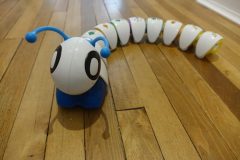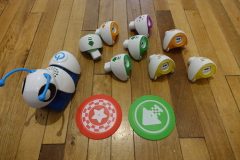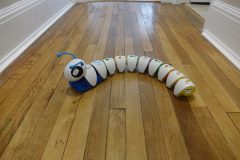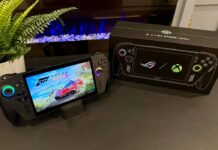 Back in the “good ‘ol days,” the most valuable skill a child could for his future career prospects was to read and write. Today, while those remain critical skills, we can also add the ability to operate a computer and even, to some degree, coding, to that list.
Back in the “good ‘ol days,” the most valuable skill a child could for his future career prospects was to read and write. Today, while those remain critical skills, we can also add the ability to operate a computer and even, to some degree, coding, to that list.
There are plenty of fun toys that are educational. But none quite like the Fisher Price Think & Learn Code-A-Pillar, which is geared toward kids aged 3 up to 8. It’s simple enough that a preschooler can enjoy hours of fun with one (indeed, I had to pry it away from my excited 3-year-old nephew when they visited one day!) but it has the potential to be complex enough for an older child to enjoy as well.
The idea: connect the caterpillar toy’s nine segments together in different ways to alter the directions in which he scoots across the floor. Each piece has a coding instruction: go left, go right, light up, or go forward. But there’s plenty more to it, as you’ll find in my in-depth review below.
Design
The Code-A-Pillar comes with its base (i.e. the head and first segment) plus eight additional plastic segments that can be attached to the base and one another via USB ports. Each one  has a direction or movement/responsive instruction on it: there are three with straight arrows, two each for right and left arrows, and one that lights up. Each has a set of wheels to help it move along the floor.
has a direction or movement/responsive instruction on it: there are three with straight arrows, two each for right and left arrows, and one that lights up. Each has a set of wheels to help it move along the floor.
Adding to the attraction for kids, especially young ones, is that each segment boasts its own bright colour, from blues to greens, yellows, and purples.
On the Code-A-Pillar’s base, which features a cute smiling face and antennae, is the speaker and “go” button, and on the underside are the wheels and power on/off switch.
My 4.5-year-old son was instantly mesmerized by the look of the device, and intrigued to find out what it could do.
Set-up
Set-up is super-easy. Sadly, getting the thing out of the packaging was not. The segments are perfectly covered by a plastic protective piece, and tied to the back or underside, which  required a combination of a knife, scissors, and plenty of patience to get everything out of the box. If I offered any advice, if would be to take this baby out of the package before you present it to a child, who might get anxious waiting for you to painstakingly get each piece out. That said, most parents are probably used to this type of packaging by now, which is often included with kid’s toys these days.
required a combination of a knife, scissors, and plenty of patience to get everything out of the box. If I offered any advice, if would be to take this baby out of the package before you present it to a child, who might get anxious waiting for you to painstakingly get each piece out. That said, most parents are probably used to this type of packaging by now, which is often included with kid’s toys these days.
The batteries are included (it’s powered by four AAs) and already inserted, which was a nice touch. So all you need to do is remove the protective cover, connect the pieces, and go.
In addition to the caterpillar itself, it also comes with a pair of “start” and “finish” discs that you can place on the floor. Position Code-a-Pillar at the start and ask your child to figure out how to get him to the finish by placing the segments in the proper order. Position the segments as desired, and press the “Go” button at the top. Code-A-Pillar takes a few seconds to process his route. Then, watch him do his thing, scooting about in the directions specified, stopping to light up, including his blinking eyes, and making robot and computer-like noises along the way.
As soon as you open up Code-A-Pillar, you’re enticed with cards that advertise expansion packs, which include additional segments you can add on to the included eight. These come in three sets: Basic offers forward, 90-degree right turn, and 90-degree left turn segments; Master Moves for 180-degree left, 45-degree right, and repeat command segments; and Silly Sounds & Lights, with noises like wacky, sleepy, and happy. Ideally, Master Moves would be best suited to the older coding enthusiast kids, and wacky sounds for entertaining  your little ones even more.
your little ones even more.
How does it work?
The pieces pull apart easily, and pop into one another just as easily. Though a small child might sometimes have trouble pushing them all the way in. My son did this a few times until I showed him that if not all of the segments light up, it means a piece somewhere isn’t pushed in all the way and he needs to double check them all.
He instantly picked up the concept, and worked to get Code-A-Pillar to the finish line we set up in the living room. However, I found he was more interested in just having Code-A-Pillar scoot about the living room, hallways, or kitchen, trying to get him to avoid objects, like walls, or navigate underneath the dining room table, for instance. The single-button operation makes it super-easy for kids to manipulate, and the toy is sturdy and lightweight enough that a toddler can grab him and carry him around the room to find the next starting spot.
With older kids, you could make obstacle courses, or even draw maps and “code” the toy to follow it.
I’ll be honest: I’ve often joked that loud toys are given as gifts by friends and family who don’t have kids, or those who don’t like you. Code-A-Pillar is loud, and might drive parents nuts if the kids want to play with him for hours on end. That said, I’d suggest limiting playtime because of this, or relegating Code-A-Pillar to a basement playroom where the kids can freely go wild. This isn’t the toy you’ll want a preschooler to play with right before bedtime. Code-A-Pillar would be better with a lower-level volume option, so it could run in a quiet mode as well.
Bottom line
In a day and age when the STEM (Science, Technology, Engineering, and Mathematics) fields are so important in education, this toy marks a great first introduction. It focuses on two of these aspects, science and technology, and lets kids figure out if/then scenarios. “If I tell him to go forward twice in a row, and turn to the left twice, he’ll be able to navigate around the coffee table,” for instance.
It’s a great toy for introducing school-aged kids to the very bare bones of coding, and fostering critical thinking and problem-solving among younger kids. You can make it as simple or as complex a toy as desired, which means it’s the kind of toy that your child can play with for years. Once he gets bored of the original, grab the expansion packs to add another level of fun and engagement.
And for young kids, it also offers the ability to encourage cognitive development and better hand-eye coordination. Kids will be calculating distance, direction, and problem-solving without even realizing it.
My only qualm with this cute toy is its level of noise. If you can get around that, it’ll be a welcome addition to any curious child’s tech-savvy toy collection.



